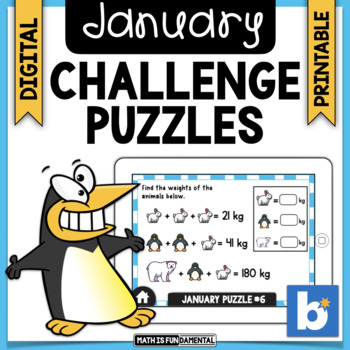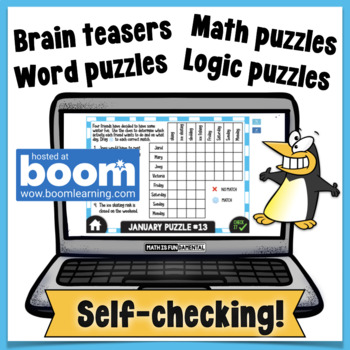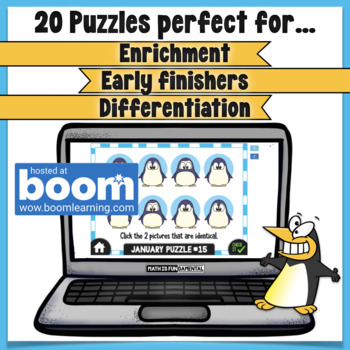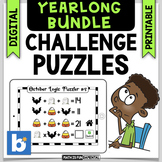January Brain Teasers & Challenge Puzzles | Boom Cards | Digital &Print
- PDF
- Internet Activities
What educators are saying
Also included in
- Do you struggle to engage and differentiate for your:early finishers?gifted and talented students?clever students who just love a challenge?Then this product is perfect for you! It includes over 240 fun and challenging brain teaser puzzles of all types. My students have LOVED solving these puzzles aPrice $36.00Original Price $72.00Save $36.00
Description
Are you looking to engage and differentiate for your:
- early finishers?
- gifted and talented students?
- students who just love a challenge?
Then this product is perfect for you! It includes 20 fun and challenging brain teaser puzzles of all types. My students have LOVED solving these puzzles as a reward for completing their other work. I LOVE that they are self-checking which frees me up to help the students who need it.
★★★★ Preview this deck in action here ★★★★
It includes 20 varied January-themed Boom card puzzles involving:
- math / numbers / patterns
- words
- logic
- pictures
- and more!
As a bonus, it includes a printable version of each puzzle that can displayed in your classroom. The printable version also includes an answer key with a brief explanation of the solution (where needed).
January Themes included in this deck: Martin Luther King Jr., New Year's, winter, football, winter animals, National Popcorn Day, and National Hugging Day
★★★Yearlong Brain Teasers and Challenge Puzzles GROWING BUNDLE★★★
Includes:
- November Brain Teaser Challenge Puzzles | Boom Cards | Digital & Print
- December Brain Teaser Challenge Puzzles | Boom Cards | Digital & Print
- January Brain Teaser Challenge Puzzles | Boom Cards | Digital & Printable
- February Brain Teaser Challenge Puzzles | Boom Cards | Digital & Print
- March Brain Teaser Challenge Puzzles | Boom Cards | Digital & Print
- April Brain Teaser Challenge Puzzles | Boom Cards | Digital & Print
- May Brain Teaser Challenge Puzzles | Boom Cards | Digital & Print
- June Brain Teaser Challenge Puzzles | Boom Cards | Digital & Print
- August Brain Teaser Challenge Puzzles | Boom Cards | Digital & Print
- September Brain Teaser Challenge Puzzles | Boom Cards | Digital & Print
- October Brain Teaser Challenge Puzzles | Boom Cards | Digital & Print
COMING SOON:
- July Brain Teaser Challenge Puzzles | Boom Cards | Digital & Print
This activity uses the website BoomLearning.com. If you are not familiar with Boom, please read below for more information.
- - - - - - - - - - - - - - - - - - - - - - - - - - - - - - - - - -
New to Boom Cards?
Those who have used Boom cards™ will tell you that they take traditional task card practice to the next level. These are digital and interactive puzzle cards adaptable for use in so many ways - as independent practice, a math center, as homework, with a tutor, as an assessment, and much more. Students love the interactivity, instant feedback, and ease of use. Teachers love that they are self-grading and simple to assign in management systems like Google Classroom™. Since they are completely digital, they are also perfect for distance learning.
- - - - - - - - - - - - - - - - - - - - - - - - - - - - - - - - - -
PLEASE READ BEFORE BUYING:
To use Boom Cards, you must be connected to the Internet. Boom Cards play on modern browsers (Chrome, Safari, Firefox, and Edge). Apps are available for Android, iPads, iPhones, and Kindle Fires. For security and privacy, adults must have a Boom Learning account to use and assign Boom Cards. You will be able to assign the Boom Cards you are buying with "Fast Pins," (play provides instant feedback for self-grading Boom Cards). Fast Play is always a free way for students to engage with Boom Cards decks. For additional assignment options you'll need a premium account. If you are new to Boom Learning, you will be offered a free trial of our premium account. Read here for details: http://bit.ly/BoomTrial.
- - - - - - - - - - - - - - - - - - - - - - - - - - - - - - - - - - - - - - - -
Click here and follow me and you will be notified when new products are released. New products are discounted 50% for 2 days.
Thank you for viewing!
~Shane






